
A calf is the young of domestic cattle. Calves are reared to become adult cattle, or are slaughtered for their meat, called veal, and for their calfskin.
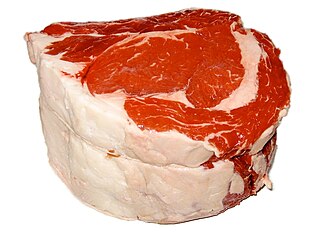
Beef is the culinary name for meat from cattle, particularly skeletal muscle. Humans have been eating beef since prehistoric times. Beef is a source of high-quality protein and nutrients.

Highland cattle are a Scottish cattle breed. They have long horns and long, wavy, woolly coats that are coloured black, brown, yellow, white, grey, "silver", or tan, and they also may be brindled. Highlands are raised primarily for their meat. They originated in the Highlands and Outer Hebrides islands of Scotland and were first mentioned in the 6th century AD. The first herd book described two distinct types of Highland cattle but, due to crossbreeding between the two, only one type now exists and is registered. They have since been exported worldwide.

The Jersey is a breed of small dairy cattle. Originally bred in the Channel Island of Jersey, the breed is popular for the high butterfat content of its milk and the lower maintenance costs attending its lower bodyweight, as well as its genial disposition. The Jersey is one of three Channel Island cattle breeds, the others being the Alderney – now extinct – and the Guernsey.
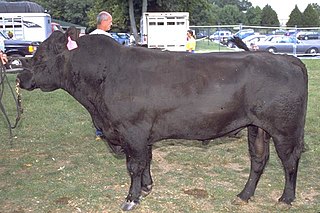
The Aberdeen Angus, sometimes simply Angus, is a Scottish breed of small beef cattle. It derives from cattle native to the counties of Aberdeenshire and Angus in north-eastern Scotland.

Holstein Friesians are a breed of dairy cattle originating from the Dutch provinces of North Holland and Friesland, and Schleswig-Holstein in Northern Germany and Jutland. They are known as the world's highest-production dairy animals.
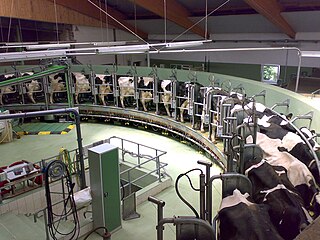
Dairy farming is a class of agriculture for long-term production of milk, which is processed for eventual sale of a dairy product.

Dairy cattle are cattle cows bred for the ability to produce large quantities of milk, from which dairy products are made. Dairy cows generally are of the species Bos taurus.

Different cattle feeding production systems have separate advantages and disadvantages. Most cattle in the US have a diet that is composed of at least some forage. In fact, most beef cattle are raised on pasture from birth in the spring until autumn. Then for pasture-fed animals, grass is the forage that composes all or at least the great majority of their diet. Cattle fattened in feedlots are fed small amounts of hay supplemented with grain, soy and other ingredients in order to increase the energy density of the diet. The debate is whether cattle should be raised on diets primarily composed of pasture (grass) or a concentrated diet of grain, soy, corn and other supplements. The issue is often complicated by the political interests and confusion between labels such as "free range", "organic", or "natural". Cattle raised on a primarily forage diet are termed grass-fed or pasture-raised; for example meat or milk may be called grass-fed beef or pasture-raised dairy. However, the term "pasture-raised" can lead to confusion with the term "free range", which does not describe exactly what the animals eat.

The Afrikaner, also known as the Africander, is a breed of taurine-indicine ("Sanga") cattle indigenous to South Africa.

South Devon cattle are a breed of British beef cattle. They are the largest of the British native breeds, and are believed to have descended from the large red cattle of Normandy which were imported during the Norman invasion of England. The breed is a rich, medium red with copper tints, though it varies in shade and can even appear slightly mottled. The breed today is predominately used for beef production although it has been milked in the past. The official governing body, The South Devon Herd Book Society was founded in 1891.
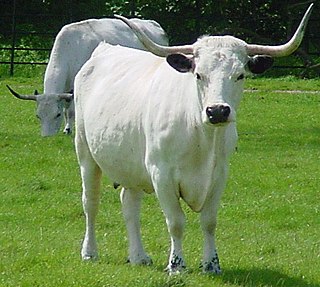
The White Park is a rare breed of ancient horned cattle primarily residing in Great Britain. Two similar semi-feral populations, the Chillingham Wild Cattle in Northumbria and the Vaynol cattle from Gwynedd in North Wales, have a separate breed status. There are relatively small numbers of the White Park cattle in the United States, where they are commonly known as the Ancient White Park in order to distinguish them from the American White Park, which is a population of the British White breed.

Glamorgan Cattle are a rare British cattle breed. Once common in the counties of Glamorgan, Monmouth, and Brecon, the breed was thought to have died out, until a remnant herd was found in the 1970s.

Beef cattle are cattle raised for meat production. The meat of mature or almost mature cattle is mostly known as beef. In beef production there are three main stages: cow-calf operations, backgrounding, and feedlot operations. The production cycle of the animals start at cow-calf operations; this operation is designed specifically to breed cows for their offspring. From here the calves are backgrounded for a feedlot. Animals grown specifically for the feedlot are known as feeder cattle, the goal of these animals is fattening. Animals not grown for a feedlot are typically female and are commonly known as replacement heifers. While the principal use of beef cattle is meat production, other uses include leather, and beef by-products used in candy, shampoo, cosmetics, insulin and inhalers.

Shetland cattle are a small, hardy cattle breed from the Shetland Isles of Scotland. They are noted for their use in crofting in Shetland, where they provided use for meat, milk and draft work. Despite the rapid decline in crofting for a living, efforts to conserve this breed in the United Kingdom are mainly done by the Shetland Cattle Breeder's Association.
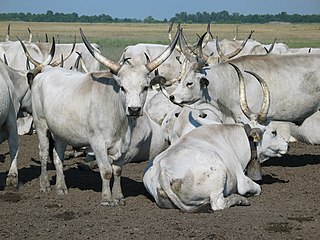
Hungarian Grey cattle, also known as Hungarian Steppe cattle, is an ancient breed of domestic beef cattle indigenous to Hungary.
Kalmyk cattle are a beef cattle breed originating in Mongolia and northwestern China and taken to southwestern Russia by migrating Kalmyk tribes in the early 17th century. They are now found in central Asia and Southern Russia on dry steppe pastures.

Bovine spongiform encephalopathy (BSE), commonly known as mad cow disease, is a neurodegenerative disease of cattle. Symptoms include abnormal behavior, trouble walking, and weight loss. Later in the course the cow becomes unable to move. The time between infection and onset of symptoms is generally four to five years. Time from onset of symptoms to death is generally weeks to months. Spread to humans is believed to result in variant Creutzfeldt–Jakob disease (vCJD). As of 2018 a total of 231 cases of vCJD have been reported globally.

A bull is an intact adult male of the species Bos taurus (cattle). More muscular and aggressive than the female of the species, the cow, the bull has long been an important symbol in many cultures, and plays a significant role in both beef ranching and dairy farming, and in a variety of other cultural activities.

A cow–calf operation is a method of raising beef cattle in which a permanent herd of cows is kept by a farmer or rancher to produce calves for later sale. Cow–calf operations are one of the key aspects of the beef industry in the United States and many other countries. In the British Isles, a cow–calf operation may be known as a single-suckler herd. The goal of a cow–calf operation is to produce young beef cattle, which are usually sold. A rancher who works within such a model is often called a "cow–calf operator" in the United States.


















